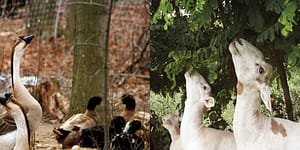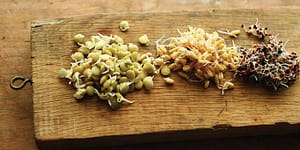The Science Behind Food Preferences: More Than a Matter of Taste

You might remember being a little kid and refusing to eat the broccoli that was put on your plate. But now you can’t get enough of the delicious green veggies. Why is it that your food preferences change over time? Why do you love some foods and despise others? What causes one person to love liver while you gag at the thought? The answers might be a little more complicated to explain than simply a difference in taste buds.
This excerpt is from Nourishment by Fred Provenza. It has been adapted for the web.
Let’s look at an example: To survive a rare lung disease, American dancer Claire Sylvia underwent a heart-and-lung transplant in 1988. Her chest was sawed open, her diseased organs removed, and in their place, doctors inserted the heart and lungs of a donor. Following surgery, she was certain that her harrowing journey was over. In reality, it was just beginning. New organs weren’t the only thing she inherited. During her recovery in intensive care, Claire began to feel the presence of someone else inside her. Initially frightened and then captivated, she realized that some of her attitudes and behaviors had changed. In A Change of Heart, Claire describes how she was shocked to discover that her food preferences had changed following her organ transplant. The cells and organs from her donor had a “mind” of their own that was now influencing what she chose to eat. After an extraordinary dream, she began to search for the family of her donor.

Why do we prefer to eat some foods but not others? What are we feeding?
Most people don’t give such questions a bit of thought, and there’s really no need to do so. The wisdom of the body takes care of these matters—without a bit of thought. As a result, people really don’t know why they prefer to eat certain foods or what they are feeding—stomach or maybe intestines—when they eat. Can cells and organ systems influence the food choices of a human or an herbivore? What kinds of learning and memory exist in cells and organ systems, and can cellular memory outlive physical death?
Liking for foods is typically thought to be influenced by palatability. Webster’s dictionary defines palatable as pleasant or acceptable to the taste and hence fit to be eaten or drunk. Animal scientists usually explain palatability, though, as a liking influenced by a food’s flavor (odor and taste) and texture, or the relish an animal shows when eating a food. Plant scientists describe palatability as attributes of plants that alter an herbivore’s preference for consuming them, such as physical and chemical composition and associated plants.
Affective and Cognitive Processes
The body integrates information about foods through affective processes and cognitive processes. Taste plays a prominent role in both processes. Receptors for taste are situated like a Janus head placed at the gateway to the body, with an “affective face” that looks at what’s happening inside and a “cognitive face” that looks at what’s happening outside.
Affective processes integrate taste with post-ingestive feedback. The type of change in liking for and intake of a food item depends on whether feedback is aversive or positive. Food likes and dislikes mediated by sensations such as hunger, satiety, and nausea are how the gut tells the brain of a body’s well-being—gut feelings. The result is incentive modification.
Cognitive processes integrate the odor and visual appearance of a food with its taste. Animals use smell and sight to select foods whose post-ingestive feedback has been positive; they avoid foods that have produced aversive feedback. Cognitive processes are strongly influenced by social models such as mother and other herd mates. The result is behavior modification.
Affective and cognitive processes are mediated by dorsal and ventral vagus nerves from the gut that converge with nerves for taste in the brain stem. From the brain stem, these nerves converge with other nerves as they relay from the brain stem to the limbic system and then to the cortex. The gut sends an enormous amount of 
Far more neurons ascend from the gut to the brain (afferent neurons) than descend from the brain to the gut (efferent neurons). For every message sent by the brain to the gut, about nine are sent by the gut to the brain. Because of the extensiveness of the enteric nervous system (afferent neurons), the gut has a great deal of sovereignty. As neurogastroenterology expert Michael Gershon notes in The Second Brain, the enteric nervous system has a mind of its own that continually informs the central nervous system about the status of the body. Following Gershon’s discovery of the gut as a complex neural system, researchers have discovered that every neurotransmitter in the brain also operates in the gut. The enteric nervous system has more neurotransmitters and neuromodulators than any other part of the peripheral nervous system.
Discoveries in other fields have helped to deepen the understanding of the results we found in our research, which showed that what makes a food “taste good” to animals is not as simple as was once thought. Bodies are integrated societies of cells and organ systems, including the microbiome, each with nutritional needs. What I call “myself” is a conduit through which the cells and organ systems that make up my body meet their nutritional needs.
I can still recall how my understanding changed the day I realized that palatability and preference are not based entirely on cognitive-rational analytical thought, but also on noncognitive-emotive-synthetic feedback that arises from within a body. The awareness that palatability is unconsciously influenced by cells and organ systems, including the microbiome, stopped me in my tracks. Until then, I’d been trained to think about foraging in a cognitive-rational-analytical sense in terms of the costs and benefits of selecting various foods.
Years later I came to appreciate that the most intriguing part of the tale reveals a dichotomy between two different kinds of rationalities. One has to do with conscious thought and the rational mind, and the other has to do with emotional experiences and the wisdom body. That’s illustrated if you ask a person why they prefer anything from foods to mates to cars. While people can tell you what they prefer, we don’t necessarily understand how their preferences originate. We don’t need to think about that any more than we have to think about which enzymes to release to digest food. The body takes care of that—without a thought.
Recent Articles
Have you heard of silvopasture? This system of managing grazing animals is an ancient practice that integrates trees and pasture into a single system for raising livestock. These systems are managed for both forest products and forage, providing short-and long-term income sources in a mutually beneficial way for healthier animals, better soil, less pest control and mowing, and…
Read MoreLearning how to ask questions that will elicit relevant information is as much an art form as creating an herbal formula. Follow this broad list as a starting point.
Read MoreOxeye daisies are one of the most important plants for pollinators including beetles, ants, and moths that use oxeye daisies as a source of pollen and nectar. Instead of thinking about removing a plant like oxeye daisy, consider how you can improve the fertility and diversity of habitat resources in your home landscape, garden, or…
Read MoreWant to start your own medicinal herb garden? Passionflower, lemon balm, and goldenseal are great places to begin! These herbs are jam-packed with medicinal properties and easy to grow in a majority of climates.
Read More








